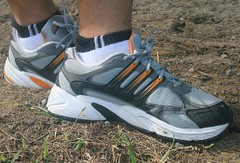In the next part (part 5) of this chapter, practical investigations to prove whether chlorophyll, light and carbon dioxide are really needed for green plants to photosynthesize will be discussed. Before these practical investigations can be discussed, it is SOOOOO necessary for you to know HOW and WHY destarching is necessary.
First thing first. In investigating these three requirements, we need to ask ourselves - How do we know whether photosynthesis is really taking place or not? And then ask further - How do we know whether these requirements are responsible or involved in any ways, in photosynthesis? Well, the answer to the first one - If photosynthesis is really taking place, starch must have been produced, right? And the second question - By conducting an investigation where one requirement is deprived from the photosynthesizing plants. OK, enough about this. Lets move on to the real objective of this part of the chapter.
WHAT IS DESTARCHING?
- Removal of starch from the leaves.
WHY DESTARCHING?
- To ensure that at the beginning of the above mentioned investigations, there are no starch in the leaves of the plants to be used in the investigations. We really need to ensure that starch is really produced or not as a result of photosynthesis in the presence or absence of the above mentioned requirements.
HOW IS IT CONDUCTED?
- By placing the plants to be used in the investigations in a dark place, for example a dark cupboard for 24 to 48 hours (Darkness will stop photosynthesis in these plants and as a result all starch stored in the leaves will be used as a source of energy)
HOW DO WE KNOW IF DESTARCHING IS SUCCESSFUL?
- If we want to know whether the destarching is successful or not, we may take one of the leaf and test it for the presence of starch using Iodine solution.
- SUCCESSFUL??? It means, the outcome of the starch test must be NEGATIVE, the brown Iodine should not change. This means that starch is absent in the tested leaf - meaning, the DESTARCHING IS SUCCESSFUL.
IODINE TEST ON LEAF FOR THE PRESENCE OF STARCH
Starch test using Iodine solution? Hmm... peculiar right? You must be thinking about the same test like the one you did in your food test practical classes? Well....not that easy missy or mister. Here's the procedures:
Procedures:
- Heat some water to boiling point in a beaker and then TURN OUT the Bunsen flame.
- Use forceps to dip a leaf in the hot water for about 30 seconds (This kills the cytoplasm, denatures the enzymes and makes the leaf more permeable to Iodine solution)
- Push the leaf to the bottom of a test tube and pour in some alcohol (ethanol) into the test tube (The alcohol will boil and dissolve out most of the chlorophyll. This makes colour changes with Iodine easier to see)
- Pour the green alcohol into a spare beaker.
- Remove the leaf (brittle at this stage) and dip it once more into the hot water to soften it.
- Spread the decolourized leaf flat on a white tile and place a few drops of Iodine solution on to it.
- If the Iodine solution changed colour to Blue black, it means that starch is still present and it means that the destarching is not successful.
- If the Iodine solution does not changed colour, it means that starch is absent in the leaf and it means that the destarching is successful
Once you get the successful outcome, then you can start to investigate!!!












